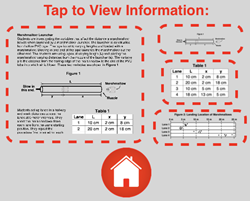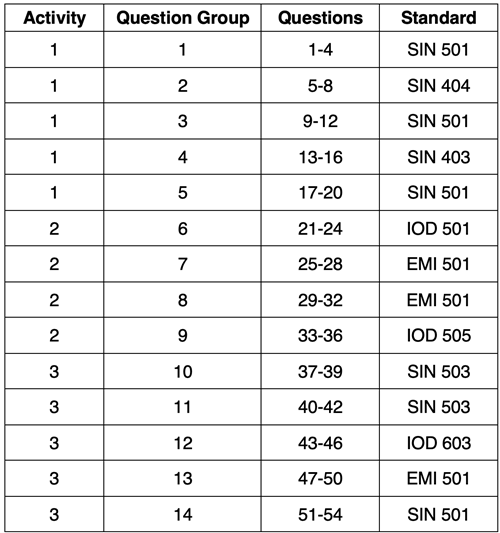About the Science Reasoning Center
 Highly Recommended
Highly RecommendedLike all our Science Reasoning Center activities, the completion of the Marshmallow Launcher activity requires that a student use provided information about a phenomenon, experiment, or data presentation to answer questions. This information is accessible by tapping on the small thumbnails found on the bottom right of every question. However, it may be considerably easier to have a printed copy of this information or to display the information in a separate browser window. You can access this information from this page.
The Standards
The Marshmallow Launcher activity describes an experiment in which students alter and test variables that impact the effectiveness of a marshmallow launcher. Data is provided in the form of a table and two diagrams. Questions target a student's ability to identify the effect of changes in a variable upon an outcome, to identify dependent and independent variables, to interpolate and extrapolate from provided data, to understand the design of an experiment, to draw conclusions that are consistent with the provided data, and to extend the findings of an experiment to a new situation.
Success with the activity requires some degree of understanding or proficiency with respect to ...
- Developing and Using Models (Science and Engineering Practice 2.1)
Evaluate merits and limitations of two different models of the same proposed tool, process, mechanism, or system in order to select or revise a model that best fits the evidence or design criteria. - Planning and Carrying Out Investigations (Science and Engineering Practice 3.1)
Plan an investigation or test a design individually and collaboratively to produce data to serve as the basis for evidence as part of building and revising models, supporting explanations for phenomena, or testing solutions to problems. Consider possible variables or effects and evaluate the confounding investigation's design to ensure variables are controlled. - Planning and Carrying Out Investigations (Science and Engineering Practice 3.5)
Make directional hypotheses that specify what happens to a dependent variable when an independent variable is manipulated. - Analyzing and Interpreting Data (Science and Engineering Practice 4.1)
Analyze data using tools, technologies, and/or models (e.g., computational, mathematical) in order to make valid and reliable scientific claims or determine an optimal design solution. - Constructing Explanations and Designing Solutions (Science and Engineering Practice 6.1)
Make a quantitative and/or qualitative claim regarding the relationship between dependent and independent variables. - Patterns (Crosscutting Concept 1.4)
Patterns of performance of designed systems can be analyzed and interpreted to reengineer and improve the system. - Cause and Effect (Crosscutting Concept 2.2)
Systems can be designed to cause a desired effect.
While the Marshmallow Launcher activity addresses the five NextGen Science and Engineering Practices and the two Crosscutting Concepts above, the activity drew its greatest inspiration from ACT's College Readiness Standards for Science Reasoning. The activity consists of 54 questions organized into 14 Question Groups and spread across the three activities. All three of the strands (Interpretation of Data - IOD; Scientific Investigation - SIN; and Evaluation of Models, Inferences, and Experimental Results - EMI) of the College Readiness Standards are addressed in this activity. The code given for the standard includes three letters to indicate the strand and three numbers to indicate the specific standard within that strand. Higher numbers are indicative of more complex science reasoning skills. The relationship between the questions and the standards is as follows:

Complementary and Similar Resources
The following resources at The Physics Classroom website complement the Marshmallow Launcher Science Reasoning Activity. Teachers may find them useful for supporting students and/or as components of lesson plans and unit plans.
Physics Classroom Tutorial, Momentum and Its Conservation Chapter: Momentum and Impulse Connections
Physics Classroom Tutorial, Momentum and Its Conservation Chapter: Real World Applications
Physics Video Tutorial, Momentum, Collisions, and Explosions: Impulse and Momentum Change
Physics Video Tutorial, Momentum, Collisions, and Explosions: Controlling Collisions
Physics Interactives, Momentum and Collisions: Egg Drop Simulation
Concept Builders, Momentum and Collisions: Law Enforcement - Being Impulsive About Collisions
Concept Builders, Momentum and Collisions: Law Enforcement - Impulse and Force
Concept Builders, Momentum and Collisions: Impulse-Momentum Change Table
Minds On Physics, Momentum and Collisions Module, Missions MC2-MC3
The Calculator Pad, Momentum and Collisions Chapter, Problem Sets MC2 - MC5
Recommended: Print Passage, Tables, and Graphs
Also see: